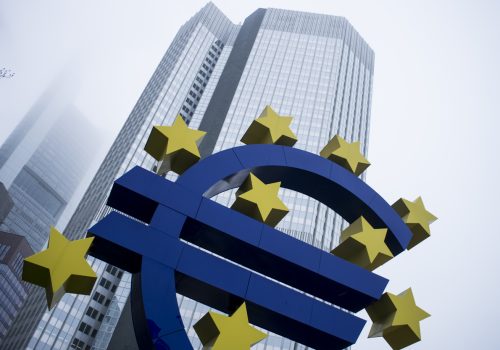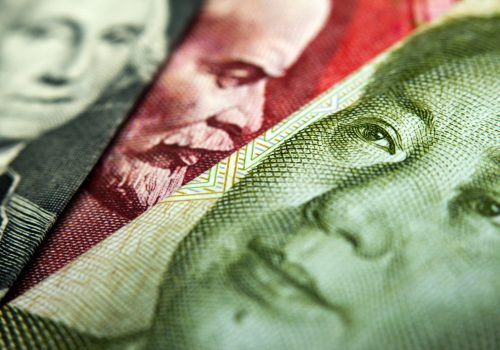Don’t expect a Plaza Accord 2.0 to reverse the dollar’s surge
The 1985 Plaza Accord created an unprecedented mechanism for market intervention to return a surging dollar to normal levels when market forces of supply and demand failed to do so. However, neither eventuality seems likely in the short-term with today’s strengthening dollar, and it may be here to stay.
The US dollar has soared against the world’s major currencies this year by 13.5 percent. It reached parity with the euro in July for the first time in twenty years. It has touched 144 yen and 0.86 pounds per dollar, levels unseen since the turn of the century. Such dollar strength can pose problems for the rest of the global economy, and history shows why.
The United States has been here before. In the early 1980s, the dollar surged by more than 50 percent against other major currencies with no signs of respite. The economic backdrop was comparable to today’s—inflation was high, and some central banks remained reluctant to hike rates while others dared to do so. In response, global economic heavyweights struck an unprecedented deal. The 1985 Plaza Accord stipulated an agreement between the United States, the United Kingdom, Germany, France, and Japan to jointly intervene in the foreign exchange markets by selling dollars to weaken the greenback. However, similar coordination is unlikely to happen again. Neither China, nor the original participants of the Plaza Accord, are willing to engage in such an agreement today.
The time-traveling dollar: From the 1980s to the 2020s
Over the past few months, the dollar has reached a relative strength only seen once since 1985. In both the early 1980s and early 2020s, major fiscal spending and rapidly tightening monetary policy generated conditions that facilitated a surge in the dollar’s value.
In the early 1980s, President Ronald Reagan implemented tax cuts to stimulate the economy. Simultaneously, the Federal Reserve System (Fed) hiked rates to tame runaway inflation, hitting a high of 19 percent in 1981 before returning to double digits in 1984 after a brief fall in between. But while the Fed was hiking rates, other major central banks darted in the opposite direction. The Bank of Japan slashed its policy rates from 9 percent to 5 percent and the Deutsche Bundesbank from 9.5 percent to 5.5 percent between 1980 and 1984.
In response to the pandemic, President Joe Biden has similarly undertaken expansionary fiscal policy through the American Rescue Plan. As inflation accelerated, the Fed responded by raising interest rates and deploying quantitative tightening. But other central banks have lagged behind the pace and extent of Fed action. The Fed has already hiked rates twice by seventy-five basis points each, while the European Central Bank has only hiked rates by fifty points, and the Bank of Japan has shied away from changing them at all.
The greenback is thus in high demand, and it is hardly a surprise that we have seen a sharp appreciation in the value of the dollar, similar to its surge in the 1980s. Higher returns as a result of higher comparative interest rates, as well as the dollar’s safe haven status during fears of a global recession, have incentivized capital inflow and strengthened the dollar exchange rate.
Don’t expect a Plaza Accord 2.0 just yet
In 1985, the dollar’s strength was hurting American exporters, especially in the auto sector. The US Treasury Secretary at the time, Jim Baker, was open to negotiations that could result in an erosion of the dollar’s strength. The end result was the Plaza Accord. The coordination between the Group of Five economies was highly successful—by the end of 1987, the dollar had more than halved its value against the yen and the deutschmark.
However, you shouldn’t expect a second iteration of the Plaza Accord—at least not yet.
For starters, the global economy today would be unrecognizable to an observer in 1985. China has emerged as one of the largest trading partners for the United States, the European Union, Japan, and the United Kingdom. While in 1985 it was easier to effectively manage exchange rates with European powers and Japan, an agreement now without Chinese participation would be ineffective as a result of its engagement in a large share of trade with those countries. China has little motivation to cooperate; right now, the yuan is not trading at levels that would force the Chinese to the negotiating table. Though that could change as the yuan falls under increasing pressure as the hawkish Fed puts US monetary policy at odds with that of China, it is unlikely to anytime soon.
More importantly, there is no political will for such an agreement among the original Plaza Accord participants. Unlike in 2013, when lawmakers pushed for a currency oversight bill, or in 2019, when President Trump demanded the Fed help weaken the exchange rate, US Treasury Secretary Janet Yellen has made clear that she wants “market exchange rates” to determine the value of the dollar. It helps her case that a strong dollar eats away at inflation, which still sits considerably higher than the Fed’s long-running target of 2 percent. Since 2013, the Group of Seven has also committed to non-intervention in currency markets, with a renewed commitment as recently as May 2022.
Things may look different if the United States enters a recession. It’s possible that inflation ebbs but dollar strength remains, hurting exporters. Indeed, that’s precisely what happened in 1985. In spite of two continuous quarters of negative GDP growth, however, the US labor market remains remarkably strong, suggesting the United States may not be in a recession yet.
A strong dollar is here to stay. So what next?
The upward momentum of the dollar value may fade, but the dollar value will likely settle at a level higher than that at the end of 2021. As in 1985, a stronger dollar will produce winners and losers.
For the United States, the stronger greenback could mildly ease inflationary pressure in the short-term by making imports cheaper. But just like 1985, it will hurt export growth as the US could become a relatively more expensive country to produce in. Dollar strength could also hamper profits of US companies abroad by deflating revenue generated overseas. Corporate growth of large firms could trim down as a result, as Microsoft, Netflix, and IBM have painfully learned.
As well, the possibilities of imported inflation will make countries other than the United States anxious, even if a persistently strong dollar promotes export growth. Nearly half of international trade is conducted in dollars, even in exchanges not involving the United States. This means most businesses worldwide trade goods across international borders in exchange for dollars, which they must then exchange for their local currency to avail their earnings. As the dollar gained strength in the last few months, traders began to pay more local currency to acquire the same amount of imports as before, thus adding to inflationary pressures on non-US economies. This will especially concern countries that rely on imports for their agricultural needs—such as Egypt and Afghanistan—and for energy needs—such as Europe and Japan.
The Plaza Accord was an unmatched agreement of economic cooperation that devalued the dollar. It shall remain so as long as China does not participate and inflation concerns persist in the United States. A new reality for the global economy of a strong dollar is on the horizon, and the global economy must prepare for its repercussions.
Mrugank Bhusari is a Program Assistant with the Atlantic Council’s GeoEconomics Center. Follow him on Twitter @BhusariMrugank
Related reading

At the intersection of economics, finance, and foreign policy, the GeoEconomics Center is a translation hub with the goal of helping shape a better global economic future.
Image: Dollar Exchange Rates Euro Yen Pound


